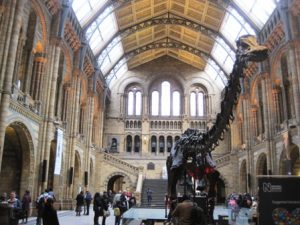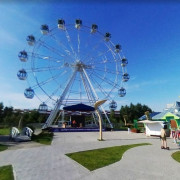Музей естественной истории в лондоне
Содержание:
- The Natural History Museum – History:
- ACCUMULATING AND CLASSIFYING
- Стоит ли посетить музей естественной истории в Нью-Йорке
- Для детей
- Lee Kong Chian Natural History Museum — Singapore
- Музей естественной истории в Лондоне
- HUMANIST NATURAL HISTORY
- Beijing Museum of Natural History — Beijing
- Melbourne Museum — Australia
- Shop and customer service
- Время работы Музея Естествознания
- Экспозиции музея
- Maturity of Natural History
- Natural History Museum — London
- Практическая информация
The Natural History Museum – History:
The museum was based on the collection of Ulster doctor Sir Hans Sloane which included dried plants and animal and human skeletons and was bought by the British Government and initially housed in the British Museum in 1756. By 1860 the collection had expanded so much that it was accepted that a separate museum would be needed. This was at a time that the subject of natural history was a topic for intense national debate – three years earlier Charles Darwin had published the Origin of Species which proposed the theory of natural selection and evolution which set his supporters at loggerheads with those who supported the Biblical explanation of creation. Work commenced in 1873 and the new museum opened in 1871. This vast and impressive building has a cathedral like frontage of sandstone with horizontal stripes of blue brick set in terracotta decorated with many ornate arches. pillars and sculptures of animals, birds, insects and fish running the whole length of the 200 metre facade. Living species are represented to the left of the entrance and extinct ones to the right. This explicit separation is thought to relate to Darwin’s theory of natural selection but it is not clear whether this was a contemporary endorsement of the theory or a rebuttal. Below the enormous central arch a wide stairway leads up to the spacious Central Hall , a gallery decorated with carved fauna and with a richly painted ceiling and housing the famous diplodocus dinosaur skeleton cast affectionately known as ‘Dippy’ which takes up the full length of the hall. The Darwin Centre extension is a recent addition to the museum and is partly designed as a storage facility for the valuable collections, but also as work space and a location for educational experiences for visitors.
ACCUMULATING AND CLASSIFYING
A number of important institutions of European science were founded during the Renaissance, supported by rulers, nobles, universities, and municipal authorities. Alongside observatories, laboratories, and anatomy theaters came the first botanical gardens: Padua (1546) and Pisa (1547). Andrea Cesalpino (1519–1603), professor of philosophy, medicine, and botany at Pisa (1555–1592) and director of the botanical garden (1554–1558), was also the creator of one of the first herbaria and the inventor of botanical systematics. Cesalpino’s classificatory system was an attempt to bring natural history within the purview of scholastic philosophy, with its logical categories and formulae. This exercise in conferring scholarly prestige upon an activity hitherto largely limited to medical herbalism enshrined botany within the universities and gave it the status of a science. Up until the end of the eighteenth century and beyond, natural historical classifications, such as that invented by Joseph Pitton de Tournefort (1656–1708), professor of botany at the Jardin du Roi in Paris (founded 1635; since 1793, the Muséum National d’Histoire Naturelle), continued to draw on Cesalpino’s work. Of all the subdisciplines of natural history, botany was the first to be formalized independently and to be practiced within institutions dedicated to its pursuit. Classification demanded not only the generation of logical categories based on a philosophical system, but also the material and practical enterprise of sorting, preserving, identifying, naming, distributing and, sometimes, propagating specimens from the three kingdoms of nature, animals, plants, and minerals. Botanical specimens far outstripped other natural history specimens such as animal carcasses or mineral samples in their portability and ease of preservation. By contrast, animal classification was contested, and reliable methods of preservation did not emerge until the very end of the seventeenth century at the hands of the Dutch anatomist Frederik Ruysch (1638–1731). Minerals, with the exception of gemstones and precious metals, were less amenable to transportation or exploitation, although they were well represented in collections devoted to local natural history.
Natural history as a cumulation of objects and observations provided both factual certainty and greater knowledge of God, but it also had economic outcomes. Europe’s botanical gardens were important centers for the acquisition, propagation, and distribution of new species derived from voyages of
discovery and conquest undertaken with increasing frequency towards the eighteenth century. The potential of replicating useful plants, including coffee, potatoes, pineapples, and nutmeg, was explored throughout the early modern period, but more systematically after the formation of the first colonial botanical gardens in the late seventeenth century. Scientific participation in the proceeds of imperialist enterprises increased substantially during the eighteenth century as naturalists presented the organized pursuit of useful plants, animals, and minerals to rulers and patrons as indispensable to national wealth. Curious natural history thus coexisted with a repertoire of activities and practices—cultivation, exchange, consumption—that would transform the flora, fauna, foods and other natural resources of western Europe forever. Such an approach to natural history as a science of resources, peaking in the eighteenth century, required extensive cooperation among naturalists as well as vast financial support. A resource-oriented approach to natural history also justified the publication of local natural histories itemizing the flora, fauna, and mineral wealth of one province or state, especially in England and the German lands.
Стоит ли посетить музей естественной истории в Нью-Йорке
На наш взгляд, однозначно стоит. Некоторые туристы даже специально прилетают в Нью-Йорк из Москвы, чтобы увидеть экспонаты. А если вы уже выбрались в поездку в США, потратили деньги на визу и купили туристическую страховку в Америку, то почему бы не использовать шанс и не побывать в столь значимом месте? Благодаря тщательно продуманной и слаженной работе ученых, художников, инженеров и фотографов эта достопримечательность Нью-Йорка на протяжении многих лет является заслуженной жемчужиной города, которую можно красным цветом выделить на карте города. А личное знакомство с ней обязательно станет одним из самых незабываемых событий в жизни. Можно частично познакомиться и через видео экскурсию:
https://youtube.com/watch?v=mxWeBK1floU
Для детей
Музей полностью ориентирован на детей, и его создателям удалось добиться, чтобы суховато академическая дисциплина открылась детям как веселое, яркое и интересное приключение. Все выставки оформлены и озвучены так, чтобы интересно было в первую очередь ребенку. Много интерактивных вещей — можно покрутить, подергать, послушать и т. д., есть симуляторы (симулятор землетрясения, например). Много занятий для детей — ребенку дадут потрогать копию кости динозавра, подержать какую-нибудь безобидную живность и т. д. Хотя надо сказать, что взрослым там интересно и без всего этого.
АДРЕС: Cromwell Road, London SW7
Lee Kong Chian Natural History Museum — Singapore

Photo: Lee Kong Chian Natural History Museum/Facebook
The Lee Kong Chian Natural History Museum in Singapore focuses on Southeast Asia conservation and biodiversity. Each of the three floors represents a different time period or theme, including heritage (with a Cabinet of Curiosities); organic material and biodiversity; and Singapore Today, featuring information on geology and earth-related activism. The museum is home to one million zoological species representing 10,000 animals, many of which are endemic to the region. Critters on display range from pangolins to fish parasites. The three sauropod skeletons and the herbarium full of rare flora are the highlights of a visit. The museum is open every day except Mondays from 10:00 AM to 7:00 PM with last admission at 5:30 PM. Adult entry costs about $12.
Музей естественной истории в Лондоне
Национальный музей естественной истории — это не просто пыльное кладбище костей динозавров, а целый научный институт, Храм природы, как его иногда называют.
Раньше я этого не знала и шла в музей без особого энтузиазма, но была приятно удивлена качеством и подачей экспонатов.
Кстати, у меня тогда был День Рождения и, пожалуй, именно благодаря Natural History Museum настроение у меня было поднято на целый день!
Вы уведите здесь по-настоящему увлекательный, красочный и оживлённый музей, наполненный детским смехом и удивлёнными возгласами взрослых.
Помимо 80 миллионов экспонатов музей хранит книги, научные работы, манускрипты и редкие художественные коллекции, к которым можно получить доступ в исследовательских целях. Это поразительное место, которое нужно посещать дружной семьёй.
Немного об истории музея и его архитектуре
До 1992 года музей Естественной истории назывался Британским музеем (Естественная История — B.M. (N.H.)), хотя отделился от него ещё в 1963 году.
Первые экспонаты прибыли из Британского музея в середине XVIII века: высушенные растения, скелеты животных и людей из коллекции сира Ханса Слоана.
Большая часть исчезла уже в начале XIX века — некоторые были проданы в Королевский хирургический колледж, прочие просто не смогли сохранить до нашего времени.
Чуть позднее к музею естественной истории присоединили Геологический музей. Перед зданием расположена модель активного вулкана (не самая впечатляющая и часто выходящая из строя), машина имитирующая землетрясение от Джеймса Гарднера и первая в мире компьютерная экспозиция Сокровища земли (Treasures of the Earth), где так же представлены коллекции минералов.
Позднее всех, в 2002 году, открылся центр Дарвина, где хранятся особо ценные коллекции, а так же располагаются офисы для научных работников и образовательные уголки для посетителей.
Как добраться до Natural History Museum
- Адрес:The Natural History Museum , Cromwell Road , London SW7 5BD .
- Ближайшая станция метро — South Kensington (жёлтая ветка/ Circle line).
- Расположение здания очень удобное, рядом находятся бесплатные для визита музеи Альберта и Виктории, а так же Музей Науки.
Самые любопытные экспонаты Музея Естествознания
Обидно пропустить экспонаты, про которые все говорят, поэтому ниже я привожу список жемчужин Музея естественных наук Лондона.
Diplodocus carnegii или просто Диппи
Символом Музея Естествознания является 32-метровый скелет диплодока. Он размещён в центральном зале, его довольно трудно не заметить. Это подарок шотландского американца Эндрю Карнеги от 1905 года.
Данный скелет стал символом музея, он упомянут даже в диснеевском мультфильме.
Модель синего кита
Поистине впечатляющая по своей величине модель: 25 метров в длину и 10 тонн весом. Сразу пытаешься представить себе его живьём, от чего невольно становиться страшновато. Долгое время ему просто не находилось места в музее, пока не был построен новый Китовый Зал (сейчас он называется Large Mammals Hall) в 1938 году.
Есть легенда, что во время сборки модели рабочие сделали дверцу в животе кита, чтобы по-быстрому отлучаться на перекур. Перед запечатыванием двери внутри кита оставили монеты и телефонные книжки, а может быть там и вовсе хранится временная капсула с различными посланиями.
Кальмар по имени Арчи
В центре Дарвина с 2004 года находится гигантский 8,62-метровый кальмар, нежно прозванный Арчи. В отличии от кита Арчи не искуственный макет. Он презервирован в формалиновом физрастворе и находится в подвальном помещении.
Обычно Арчи не выставляют на публику, поэтому нужно онлайн заказывать билеты на специальный тур под названием Behind-the-Scenes Spirit Collection Tour здесь. Билет стоит €12 (£10) для всех + бронирование €2.50 (£1.50) (для справки: helper, который может пройти бесплатно, это сопровождающий для человека с инвалидностью).
Кости кита, заблудившегося в Темзе
Это грустная история. В 2006 году один кит совершенно случайно забрёл в реку Темзу.
К сожалению, он не выжил, и его останки сначала сохранили для исследовательской работы, а уже позднее переместили кости в основной зал.
Динококлеа это ракушка огромной улитки, согласно одной теории срощенный туннель для червей или же копролит. Копролит это… окаменевшие фекалии древнего животного. Совершенно тошнотворное зрелище, но с 1921 года занимает гордое место в коллекции музея.
P.S. Детям лучше сказать, что это ракушка гигантской улитки.
HUMANIST NATURAL HISTORY
Sixteenth-century natural history was part of the humanist tradition of learning with its literary and artistic orientation, typified by the writings of the Dutch scholar and theologian Desiderius Erasmus (1466?–1536). The study of the natural world in the early modern period was first and foremost a philological pursuit. Authors of new publications plundered earlier manuscript and published works of natural history for descriptions, anecdotes, and proverbs concerning natural objects, including many that would today seem quite foreign to a scientific approach. The Milanese jurist Andrea Alciati’s Emblemata (1522) configured animals as literary puzzles, with an obscure image and motto that the reader could decode by means of an epigrammatic poem. Emblematic texts of natural history accumulated literary materials rather than observations: fables, emblems, proverbs, allegories,
sympathies. This emblematic tradition emphasized the symbolism of animals alongside their uses, rather than their anatomy or classification; it continued to dominate natural history until the very end of the sixteenth century, exemplified in the writings of naturalists such as the Lutheran Joachim Camerarius the Younger (1534–1598).
By the end of the sixteenth century, learned men across Europe collected natural history objects and advanced explanations for their nature, types, and transformations. Massive publication projects were often associated with collections like the famous studio of the «Bolognese Aristotle,» Ulisse Aldrovandi (1522–1605). The great collections of individuals like Aldrovandi, the Neapolitan apothecary Ferrante Imperato (1550–1631) or the Dane Olaus Worm (1588–1654) were famous throughout Europe, visited by princes and noblemen, and documented in printed descriptions and catalogs such as the Museum Wormianum of 1655 in Leiden. Collections continued to play a central part in princely and scholarly identity, as in natural historical practice, throughout the early modern period, although the principles of their construction varied over time. In his many writings, the English philosopher Francis Bacon (1561–1626) called for the ejection of philology from natural history and for greater attention to wonders and monsters, the exotic and the rare. By the 1660s, museums were theaters of marvels, where the scholarly observer was encouraged to contemplate the philosophical issues raised by the juxtaposition of neighboring objects, which might reveal contrasts or similarities, the variety or the uniformity of nature. The wondrous natural or artificial object served as a basis for philosophical analysis, natural theology, and reflection on the role of the human observer, both as part of the natural world and as the transformer of its materials by art. Such studies always had a theological purpose as well: museums of natural history were described as «books of nature,» which the scholar could read alongside the great book, the Bible, for pious purposes. This natural theological approach was typified by the writings of the Cambridge botanist John Ray (1627–1705).
Beijing Museum of Natural History — Beijing
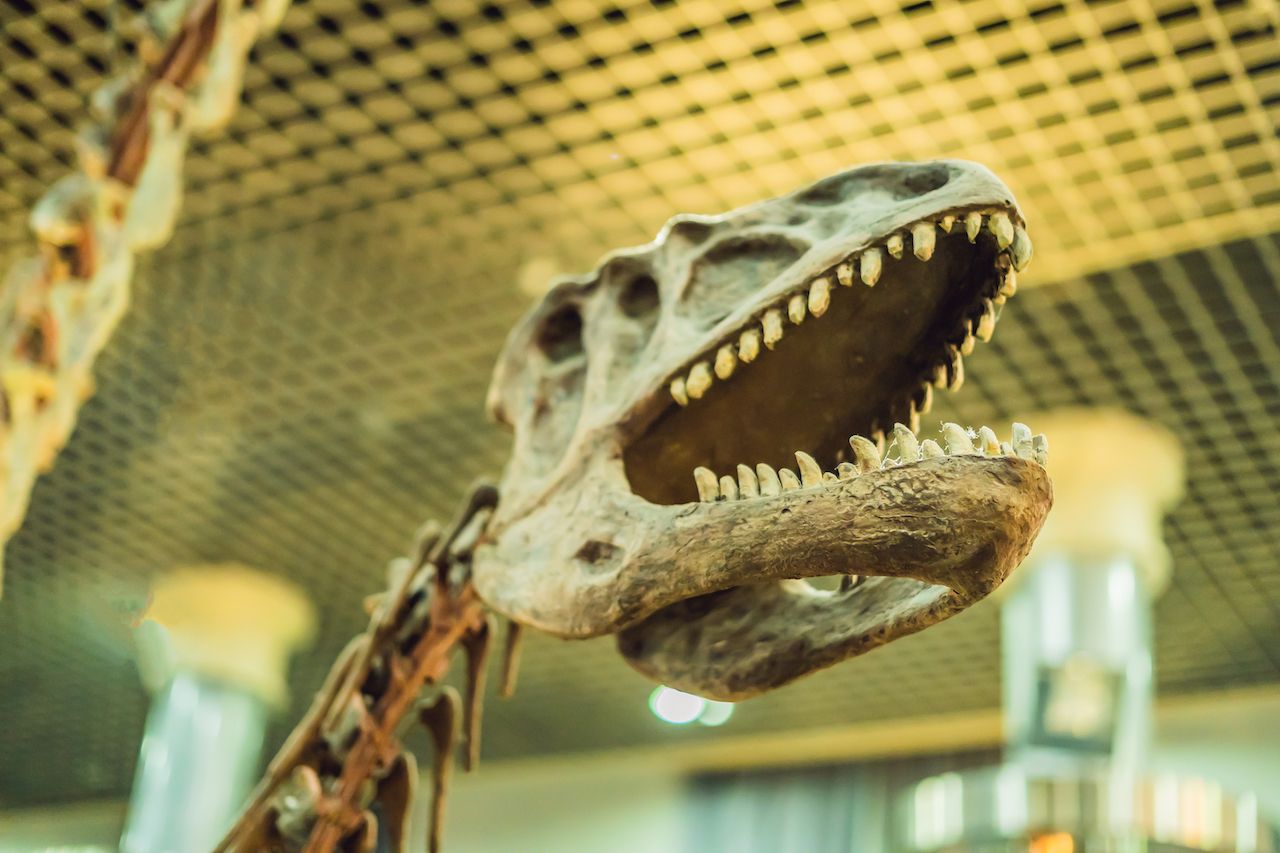
Photo: Elizaveta Galitckaia/Shutterstock
Admission to most exhibits in this gigantic Chinese natural history museum is free. In this case, “gigantic” means more than 86,000 square feet of display space, so there’s no way a person could see everything in a day. The museum is best known for its collection of rare, mummified, and fossilized dinosaurs, especially the world’s only known intact Stegodon zdanskyi skull. Another interesting exhibit is the South China Sea marine life display, with 10 sections and more than 500 specimens. The museum is open from 9:00 AM to 5:00 PM daily except for Mondays, with last entry at 4:30 PM. Check out the museum’s website before setting off.
Melbourne Museum — Australia
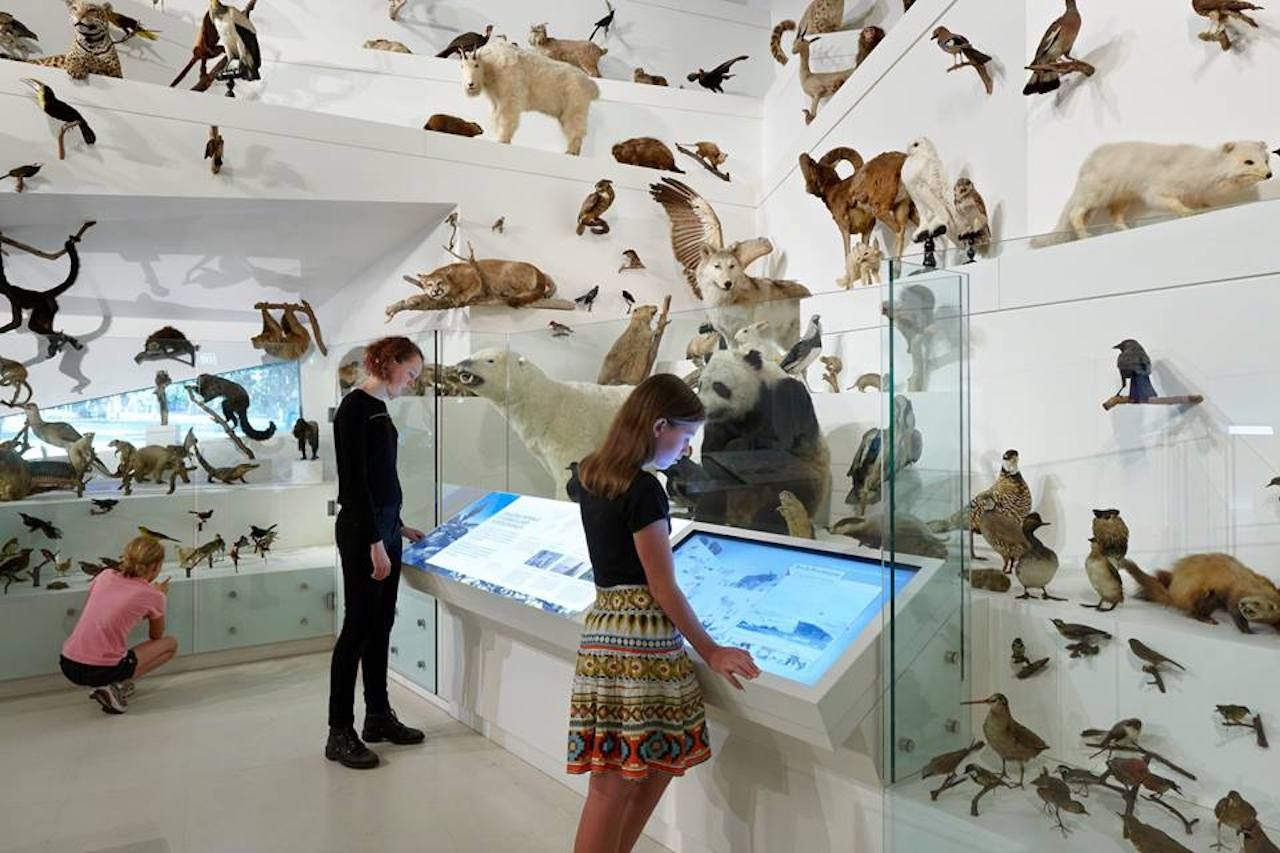
Photo: Melbourne Museum/Facebook
The Melbourne Museum isn’t just a natural history museum, but there’s certainly a significant enough element of plants, animals, other such treasures to satisfy anyone’s thirst for knowledge. Some exhibitions focus on indigenous Australian culture and artifacts, and their usage of flora and fauna. There’s an experiential Mind and Body Gallery, in which visitors explore the mind via thoughts, emotions, and dreams. Museum-goers walk through a stand of Victoria’s living forest, and, of course, there are dinosaurs (along with more than 600 birds, reptiles, and amphibian specimens from around the world). There’s an IMAX theater, exhibits on marine life and climate, and an ongoing microbe gallery that explores what’s going on in the human gut. The museum is open every day except Good Friday and Christmas from 10:00 AM to 5:00 PM. Admission is about $10. Bonus: The museum touts itself as autism-friendly, offering maps to high- and low-sensory spaces, social scripts, and quiet zones.
Shop and customer service
Museum Customer Service
Cash desk: +3582941 28800 (during opening hours)Guided tours and bookings: opastukset@luomus.fi tel. +3582941 28855 on Mon. and Thu. at 1-3 pm.Professional filming/photography: tilat@luomus.fi tel. +3582941 28899 Mon.-Thu. at 10 am-3 pm.Facility rentals: myynti@ruokalahettilas.fi +358(09) 867 8860
NB! There is no telephone service (apart from the cash desk) during school holidays: weeks 52-2 (Christmas), week 8 (winter break), weeks 25–31 (summer break), week 42 (autumn break), and midweek holidays.
Café and museum shop
The Natural History Museum has a café and a museum shop. They’re located on the first floor and maintained by Ruokalähettiläs Oy. You can contact the café and shop by phone: +358400 286202. During the summer (1.5.-31.8.), the museum café and shop are open:
Monday closed
Tuesday 10.30 am – 5 pm
Wednesday 10.30 am – 5 pm
Thursday 12 am – 8 pm
Friday 12 am – 7 pm
Saturday 10 am – 5 pm
Sunday 10 am – 4 pm
Время работы Музея Естествознания
| Время работы | Последний вход | |
| Ежедневно | с 10.00 до 17.50 | 17.30 |
Музей работает ежедневно, кроме 24-25 декабря. Вход бесплатный, фотографировать разрешено везде.
Залы музея естествознания
В музее естественной истории множество залов, разделяемых по цвету, а также несколько входов.

Красная зона. Одна из лучших в музее.
Главный вход находится на Кромвель-роуд и ведет прямо в центральный холл, где вас встретит не что иное, как скелет гигантского диплодока.

Главный холл.
Именно отсюда большинство посетителей растекается по различным зонам, здесь же начинаются все экскурсии.
Всего в музее естествознания 4 различных зоны:
Красная зона
 Красная зона дает представление о геологических особенностях земли. Здесь собрано множество экспонатов камней, различные вулканические и земные ископаемые, есть даже симулятор землетрясений.
Красная зона дает представление о геологических особенностях земли. Здесь собрано множество экспонатов камней, различные вулканические и земные ископаемые, есть даже симулятор землетрясений.
- 1. Земной холл
- 2. Зал неизгладимых впечатлений
- 3. Земная лаборатория
- 4. Галерея: с самого начала времен
- 5. Сокровища земли
- 6. Зал беспокойных поверхностей
- 7. Вулканы и землетрясения

Жертвы вулкана.
Обсидиан.
Коллекция минералов.
Осколок метеорита
Как волны точат камень.
Весьма интересная книга.
Очень красивый кристалл соли.
Красивые минералы и камешки.
Зеленая зона
Зеленая зона предлагает исследовать экологию земли, встретить додо и познакомиться с различными представителями животного мира.
- 1. Зал исследований
- 2. Галерея экологии
- 3. Ископаемые морских рептилий
- 4. Зал птиц
- 5. Лучшие фотографии дикой природы за год
- 6. Галерея насекомых и членистоногих
- 7. Минералы и метеориты
- 8. Сокровища Кэдогана
- 9. Гигантская Секвойя
Гигантский двигающийся скорпион.
Птички на жердочке.
Ископаемые останки морской рептилии.
И еще один морской обитатель.
Черепашка-симпатяжка.
Вход в зал членистоногих.
Милая сколопендра… пока она за стеклом.
Эволюция бабочки.
Самый большой краб!
Оранжевая зона
Оранжевая зона принадлежит царству природы. Здесь расположен центр Дарвина и различные выставки растений.
- 1. Сад дикой природы (вход со двора).
- 2. Кокон (вход).
- 3. Дух зоологии.
- 4. Студия кино
Сад дикой природы.
Синяя зона
Синяя зона — самая интересная из всех. Здесь находится зад динозавров, чучело гигантского кита и представлено большое разнообразие различных животных.
- 1. Зал динозавров
- 2. Зале человеческой биологии
- 3. Зал млекопитающих
- 4. Зал временных выставок
- 5. Зал млекопитающих (синий кит)
- 6. Зал морских беспозвоночных
- 7. Рыбы, амфибии и рептилии
Скелет динозавра.
Этот зал самый посещаемый. И дети, и взрослые рвутся именно сюда, чтобы полюбоваться на скелеты динозавров, различные ископаемые и… настоящего тиранозавра!
Вот он, красавчик!
Во всей красе. Рычит, красуется и всячески показывает, какой он грозный.
Есть фигурки и поменьше. Они тоже двигаются, но не рычат.
Смотреть можно, а трогать — нельзя.
За стеклом в шкафах стоят различные миниатюрные фигурки динозавров. Похожие можно купить в магазинчике музея.
Маленькие зубастики.
Я бы такого дома завела.
И есть множество скелетов. Как целых, так и частично сохранившихся.
Скелет динозавра.
Осмотр можно начинать с любого зала, все зависит, в какой вход вы войдете. Лично я бы посоветовала входить через красную зону. Вход находится прямо рядом с музеем науки и там практически никогда нет очереди, чего не скажешь про главный вход.
Как добраться до Музея Естествознания?
- Музей находится на «площади трех музеев» рядом с Музеем Науки и Музеем Виктории и Альберта.
- Ближайшее метро: South Kensington
- На автобусе:
- № 14, 49, 70, 74, 345, 360, 414, 430 – остановка у станции South Kensington, время до музея – 5 минут.
- № 9, 10, 52, 452 и 70 – остановка напротив Royal Albert Hall, оттуда пушком – 5 минут.
Что было раньше — курица или яйцо?
Музей естествознания обязательно стоит посетить, он понравится как детям, так и взрослым, благодаря интересным экспозициям и обучающим интерактивным играм.
Экспозиции музея
Все обширные экспозиции Музея естествознания упорядочены по тематике и располагаются в четырех основных зонах: синей, зеленой, красной и оранжевой. Прежде чем начать экскурсию по этим зонам посетители музея попадают в Центральный зал, который настраивает на осмотр коллекций и сам содержит несколько интереснейших экспонатов. Как, например, гигантская копия скелета диплодока, состоящая из сотен тысяч деталей. На главной лестнице Центрального зала установлена скульптура, изображающая одного из самых прославленных мировых ученых – Чарльза Дарвина.
Синяя зона Музея естествознания предлагает посетителям познакомиться с экспозициями, в которых представлены рыбы, земноводные, динозавры и различные жители морских и океанских глубин. Многие модели доисторических животных или рептилий являются интерактивными, т.е. двигаются, устрашающе щелкают зубами или скребут когтями, рычат. За символическую плату в 1 фунт посетители музея могут сменить последовательность действий модели или увидеть что-то новое, что недоступно в «бесплатной версии». Таким нехитрым образом музей, посещение которого бесплатное, умудряется собрать за год вполне кругленькую сумму на свои нужды. В синей зоне также можно увидеть самого большого на планете млекопитающего – голубого кита, чья 30-метровая копия подвешена под потолком.
 Синяя зона Музея
Синяя зона Музея
В зеленой зоне, как можно догадаться из названия, располагаются экспозиции, посвященные растениям, насекомым и птицам. Большой популярностью пользуется галерея с обширной коллекцией чучел, представляющих самых различных представителей мира пернатых. Среди экспонатов можно увидеть, как существующих ныне птиц (от миниатюрных колибри до огромных страусов), так и уже вымершие экземпляры. Также в зеленой зоне освещаются вопросы экологии, которые плачевно влияют на сохранение жизни на нашей планете. С помощью различных интерактивных экспонатов и информации на дисплеях посетители Музея естествознания могут больше узнать о том, какую роль суждено играть человечеству на земле и о том, как сохранить окружающую среду.
 Зеленая зона музея
Зеленая зона музея
В красной зоне музея демонстрируются различные геологические процессы на земле, землетрясения, вулканы, а также воссозданы модели приливов и отливов. Все экспонаты, расположенные здесь, не просто зрелищные, но и позволяют прочувствовать многие процессы с помощью тактильных ощущений. Например, экспонат, симулирующий процесс землетрясения, позволяет посетителям почувствовать, как происходят подземные толчки, оценивающиеся разными баллами по шкале.В красной зоне также находятся различные экспонаты, которые иллюстрируют представление древних цивилизаций о Земле и ее происхождении. Здесь немало макетов посвящено мифам и легендам, и можно увидеть не совсем обычные экспонаты, как, например, череп Циклопа.
Замыкает череду экспозиций музея оранжевая зона, в которой располагается Сад дикой природы. Здесь посетителям представлены коллекции насекомых, а также удивительные растения-хищники, которые питаются насекомыми. Кроме экспозиций в оранжевой зоне функционирует Центр Дарвина.
Лондонский музей естествознания открыт для посещений ежегодно, кроме периода празднования Рождества (24-26 декабря). С понедельника по субботу музей принимает посетителей с 10 до 17-50, а в воскресенье – с 11 до 17-50. Посещения музея является бесплатным для всех категорий.
Maturity of Natural History
The nineteenth century was rich in new theoretical approaches that attempted to explain the vast diversity in nature and the patterns that were emerging. On a more practical level, international commissions were established and worked to produce agreed-upon standards in nomenclature, bringing Linneaus’s goal of unity in naming closer. Museum curators developed taxidermic techniques that eliminated the threat of insect pests and pioneered new methods of display that would culminate in the wonderful dioramas of the American Museum of Natural History in New York, the Biological Museum in Stockholm, and in the hundreds of other large museums that were established. Natural history museums became standard institutions in all major cities, and the new museums were large, well funded, and well attended. By 1900, there were 250 natural history museums in the United States, 300 in France, and 150 in Germany. Beyond the United States and Europe there were museums from Melbourne to Bombay, from Buenos Aires to Montreal. Along with the development of museums, there was a parallel development of zoological and botanical gardens that displayed and did research on living specimens. These were extraordinarily popular: In its first year, 1828, the Zoological Gardens in London’s Regent Park had 130,000 visitors, and over the following decade that number swelled to a quarter of a million a year. By the 1880s, the garden attracted more than 600,000 people a year. With size and public support, the zoological and botanical gardens played new and important roles other than public entertainment and scholarly research. Kew Garden, outside London, functioned in an important manner in the global agricultural network that linked British interests to the transfer of important economic plants such as rubber plants and cinchona trees (important for quinine) throughout the empire. The New York Zoological Society Park pioneered the preservation of endangered species.
Important as these institutional and technical developments were, they have been somewhat overshadowed by the major intellectual synthesis provided by Charles Darwin (1809–1882). His theory of evolution by means of natural selection resolved the leading questions in natural history and also provided an intellectual structure that has proved to be the unifying theory of the life sciences. Like other naturalists of the nineteenth century, Darwin had been struck by the enormous diversity in nature and the interesting patterns of distribution that he and others observed. He was, similarly, curious about the relationship of fossils to living forms, and like many of his contemporaries who were trying to classify large groups, he attempted to sort out the differences between varieties and species. He approached the study of natural history with a secular perspective and sought natural explanations for the questions he asked. In an interesting sense, he combined and synthesized the traditions stemming from Linnaeus and Buffon. He sought the key to a classification and nomenclature system, and was searching for a secular vision of the order in nature. His Origin of Species (1859) has served as a model for how to envision and study nature.
Not that everyone agreed with his conclusions or his methods. For several decades scientists debated Darwin’s theory. Some, like Louis Agassiz (1807–1873), did not want to break the tie between natural history and religion, while others were disturbed by numerous scientific problems: the age of the earth was not believed to be old enough for the process to have occurred, the theories of inheritance did not adequately explain how variation arose or how it could be transmitted in a way that supported the theory. Those in the medical sciences had been making great strides in investigations by using the experimental method and were elaborating a theory of the body based on an understanding of the cell. It was not clear how Darwin’s science fit with that body of research. This latter issue was of special importance because many universities and other institutions were tending to see natural history as «old fashioned» by the end of the century and sought a new synthesis for the
life sciences in the exciting research stemming from the experimental sciences that were elucidating how the body functions.
Natural History Museum — London
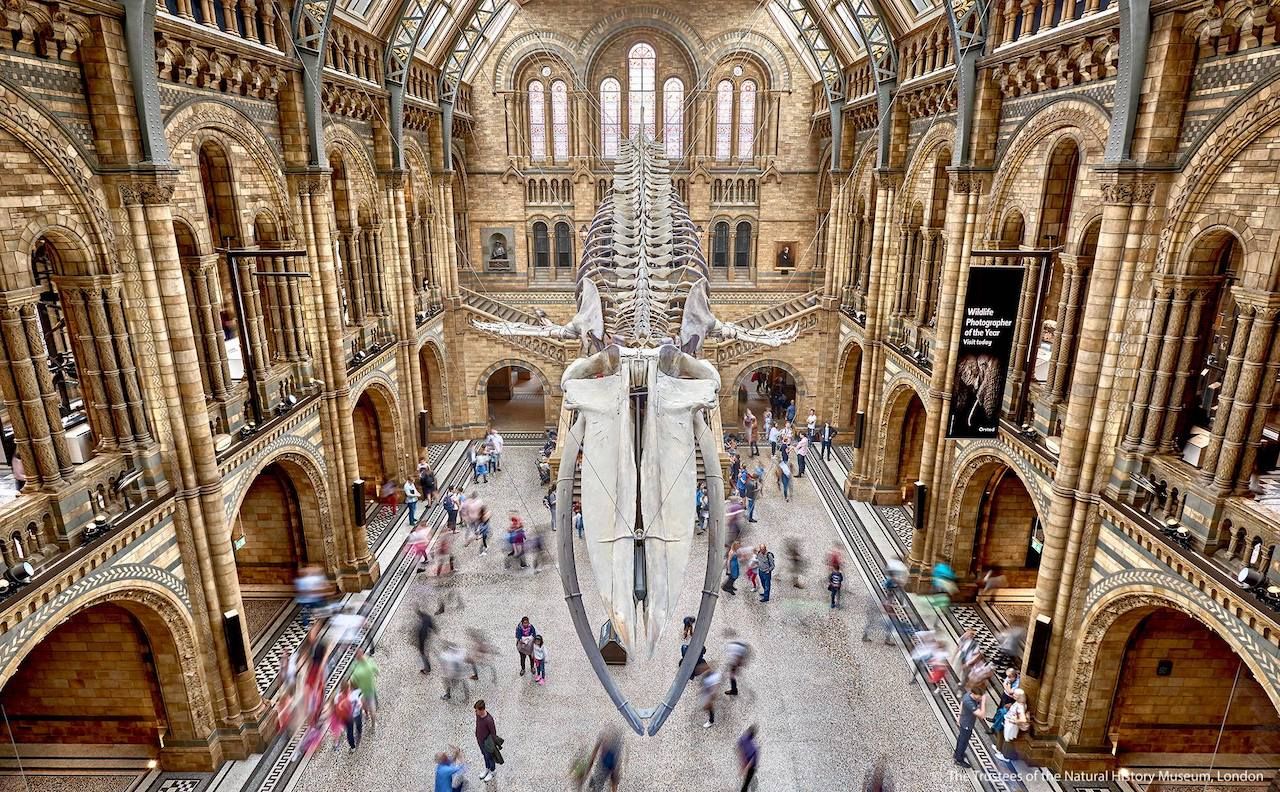
Photo: Natural History Museum, London/Facebook
London’s Natural History Museum in South Kensington is something like a grand-scale hall of curiosities divided into four zones: blue (biology); green (evolution); red (geology); and orange (outdoors/hands-on). A giant blue whale skeleton stretches along the length of the Green Zone’s ceiling. In the Red Zone, you’ll also find some of the world’s rarest minerals, like a fully crystallized gold nugget found in Australia. The Blue Zone holds a collection of interesting creatures preserved in jars of spirits, as in the alcoholic variety. Luckily, outside the museum, the Orange Zone features a (living!) wildlife garden, which could help offset any guilt acquired by looking at dead critters floating in containers of booze. There’s a space area, a human evolution exhibit, and a British animalia collection. The museum also has a branch in Tring, and entry to both branches is free. Both are open every day of the year except December 24-26. The Kensington branch is open from 10:00 AM until the last admission at 5:30 PM. The Tring branch keeps slightly different hours and exhibits. Check out the museum’s website for full details.
Практическая информация
Музей открыт ежедневно (даже во все праздничные дни, кроме Рождества) с 10:00 до 17:50, а в последнюю пятницу каждого месяца — до 22:30. Вход бесплатный для всех.
Следует учесть, что в музее всегда много детей и детских школьных экскурсий, поэтому там всегда шумно.
Расположен музей здесь: London, SW7 5BD, Cromwell Road, Natural History Museum. Он очень близко к станции метро «Южный Кенсингтон», есть подземный переход из вестибюля станции прямо к музею. Станция почти всегда перегружена.
Все системы музея созданы в расчете на детей и семейные посещения: есть детские туалеты и пеленальные комнаты, раздевалки принимают коляски, во всех кафе и ресторанах детское меню и т. д.
